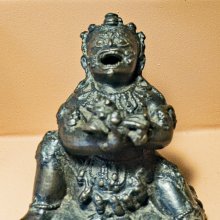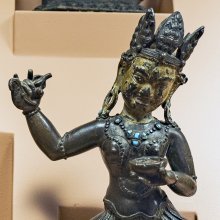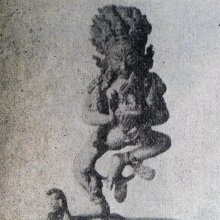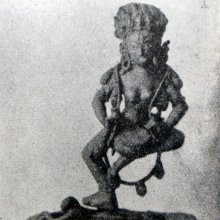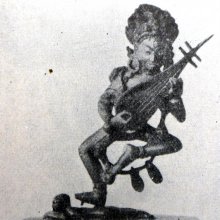Vajradaka, Vajraḍāka, Vajra-daka: 6 definitions
Introduction:
Vajradaka means something in Buddhism, Pali, Hinduism, Sanskrit. If you want to know the exact meaning, history, etymology or English translation of this term then check out the descriptions on this page. Add your comment or reference to a book if you want to contribute to this summary article.
Images (photo gallery)
In Buddhism
Tibetan Buddhism (Vajrayana or tantric Buddhism)
Source: Wisdom Library: Tibetan BuddhismVajraḍāka (वज्रडाक) is the name of a deity presiding a group of four sacred districts, according to the Abhidhānottarottaratantra and the 9th-centruy Vajraḍākatantra.—Accordingly, Vajraḍāka presides over the districts Pretapurī (Pretādhivāsinī), Gṛhadevatā, Saurāṣṭra and Suvarṇadvīpa.
Source: Google Books: An Illustrated History of the MandalaVajraḍāka (वज्रडाक) corresponds to the Buddha named Heruka and represents the main deity of the center maṇḍala of the Pañcaḍākamaṇḍala, according to the Vajrapañjaratantra.
Source: academia.edu: Perfect Realization (Sādhana) of Vajraḍāka and His Four Magical FemalesVajraḍāka (वज्रडाक) or Vajraḍākamahātantrarāja is a scripture belonging to the Buddhist Cakrasaṃvara (or Saṃvara) scriptural cycle, and is thought to have been compiled in the eastern area of the Indian subcontinent around the tenth century. The 12th chapter is a sadhana (sādhana or “perfect realization”) of Vajraḍāka (vajraḍākasyasādhana). More precisely, it is a manual of meditation to visualize a mandala (maṇḍala) consisting of the supreme deity named Vajraḍāka and his retainer deities.
According to the Vivṛti, [regarding the sādhana of Vajraḍāka], the deity Vajraḍāka is dark-blue, is greatly terrifying, is adorned with a wreath of skulls (kapālamālā), has four arms, has four faces with three eyes on each, is shining, is dancing on the sun disk on a human corpse, and holds a skull bowl (kapāla), a skull staff (khaṭvāṅga), a bow (dhanus) and an arrow (bāṇa) with his four hands.
Source: academia.edu: The Structure and Meanings of the Heruka MaṇḍalaVajraḍāka (वज्रडाक) is the name of a Vīra (hero) who, together with the Ḍākinī named Ḍākinī forms one of the 36 pairs situated in the Vajracakra, according to the 10th century Ḍākārṇava chapter 15. Accordingly, the vajracakra refers to one of the four divisions of the sahaja-puṭa (‘innate layer’), situated within the padma (lotus) in the middle of the Herukamaṇḍala. The 36 pairs of Ḍākinīs and Vīras [viz., Vajraḍāka] each have one face and four arms; they hold a skull bowl, a skull staff, a small drum and a knife; they are dark-bluish-black in color.
Source: academia.edu: A Critical Sanskrit Edition and a Translation of Kambala’s Sādhananidhi, Chapter 8Vajraḍāka (वज्रडाक) (alias Heruka) and his consort Vārāhī are deities associated with the syllable “hūṃ” of the Quasi-heart Mantra of Heruka (upahṛdayamantra): one of the four major mantras in the Cakrasaṃvara tradition, as taught in the eighth chapter of the 9th-century Herukābhidhāna and its commentary, the Sādhananidhi. The Upahṛdaya-mantra consists of seven letters. [...] The purity of these seven deities [viz., Vajraḍāka] is the Seven Limbs of Enlightenment (bodhyaṅga).

Tibetan Buddhism includes schools such as Nyingma, Kadampa, Kagyu and Gelug. Their primary canon of literature is divided in two broad categories: The Kangyur, which consists of Buddha’s words, and the Tengyur, which includes commentaries from various sources. Esotericism and tantra techniques (vajrayāna) are collected indepently.
Languages of India and abroad
Sanskrit dictionary
Source: Cologne Digital Sanskrit Dictionaries: Edgerton Buddhist Hybrid Sanskrit DictionaryVajraḍāka (वज्रडाक).—name of a supernatural being (compare next): Sādhanamālā 466.1 etc.
Sanskrit, also spelled संस्कृतम् (saṃskṛtam), is an ancient language of India commonly seen as the grandmother of the Indo-European language family (even English!). Closely allied with Prakrit and Pali, Sanskrit is more exhaustive in both grammar and terms and has the most extensive collection of literature in the world, greatly surpassing its sister-languages Greek and Latin.
See also (Relevant definitions)
Starts with: Vajradakamahatantra, Vajradakamahatantraraja, Vajradakatantra, Vajradakavivriti.
Full-text (+7): Vajradakamahatantra, Vajradakamahatantraraja, Vajradakatantra, Vajradehamandala, Bhutamandala, Upahridayamantra, Amnayamanjari, Jyotirmanjari, Bhavabhadra, Nanamnaya, Amnaya, Abhayakaragupta, Bhavabhatta, Vamsha, Mukunda, Muraja, Vina, Dakarnavatantra, Pretadhivasini, Saurashtra.
Relevant text
Search found 2 books and stories containing Vajradaka, Vajraḍāka, Vajra-daka, Vajra-ḍāka; (plurals include: Vajradakas, Vajraḍākas, dakas, ḍākas). You can also click to the full overview containing English textual excerpts. Below are direct links for the most relevant articles:
The Indian Buddhist Iconography (by Benoytosh Bhattachacharyya)
Figure 209 - Musical Instruments Deities: Vīṇā
Figure 210 - Musical Instruments Deities: Mukundā
Blue Annals (deb-ther sngon-po) (by George N. Roerich)
Chapter 3b - The Life story of 'Khon phu ba < [Book 4 - New Traditions of Secret Mantra]
Chapter 29 - Sonam Gyatso (vii): Labors for the doctrine < [Book 10 - The Kālacakra]
Chapter 2 - Guhyasamāja-tantra system of Noble Nāgārjuna < [Book 7 - The preaching of the Tantras]
